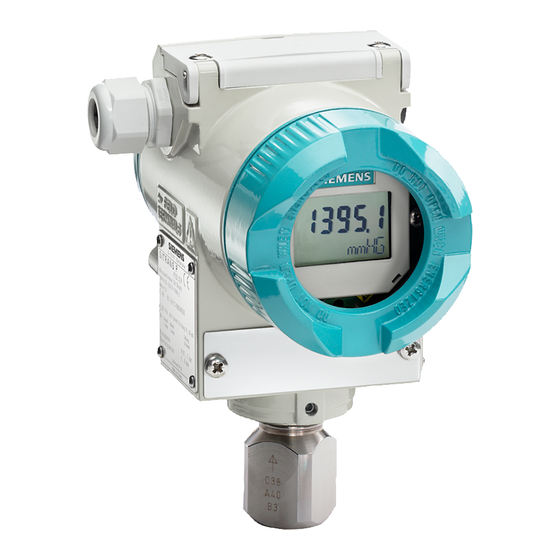Summarization of Contents
1.0 Introduction
1.2 Product Description
Overview of SITRANS P DSIII transmitters, their function, and core components.
1.3 Rating, Approval, and Tag Plates
Information on transmitter rating, approval, and tag plates for identification.
1.4 Configuration
Details on transmitter configuration methods and storage.
1.5 Product Support
Information on where to get support for the product.
2.0 Model 275 Universal HART Communicator
2.1 Introduction
Introduction to the HART communicator's role and capabilities.
2.2 Communicator Connections
Procedures for connecting the HART communicator to a transmitter loop.
2.3 Controls Overview
Description of the HART communicator's functional areas: display, keys, and buttons.
2.4 Getting to Know the Communicator
Explains communicator operation modes, display icons, and menu structures.
2.5 Main Menu
Navigation through the HART communicator's main menu options.
2.6 Using the Quick Access Key
Instructions on utilizing the Quick Access Key for frequent tasks.
3.0 Pre-Installation Test
3.1 Procedure
Steps for performing a complete transmitter functional test before installation.
3.2 Establishing Communication
Procedure for establishing communication between HART communicator and transmitter.
3.3 Testing the Transmitter
Performing an extended self-test on the transmitter.
3.4 Reviewing Configuration Data
Ensuring stored configuration data is correct before placing transmitter in service.
3.5 Checking Transmitter Output
Verifying transmitter output accuracy by applying pressure and checking current.
4.0 Installation
4.1 Equipment Delivery and Handling
Guidelines for receiving, inspecting, and storing transmitter equipment.
4.2 Environmental Considerations
Selecting transmitter locations to minimize environmental effects.
4.3 Pre-Installation Considerations and Calculations
Essential considerations and calculations for successful mechanical and electrical installations.
4.4 Mechanical Installation
Describes mechanical installation of transmitters and electrical conduit.
4.5 Mechanical Installation, All Models
Rotating enclosure, orienting display, and installing electrical conduit.
4.6 Electrical Installation
Details loop wiring for Point-to-Point and Multi-Drop networks, including hazardous locations.
4.7 Hazardous Area Installation
Specific wiring and barrier selection for hazardous location installation.
5.0 Post-Installation Test
5.1 Test Equipment
Lists required equipment for post-installation testing and calibration.
5.2 Installation Review
Verifying correct transmitter model and installation against documentation.
5.3 Equipment Connection
Shows how to connect test equipment for system checkout.
5.4 Verification
Tests for communication, error checks, analog output, and configuration.
5.5 Transmitter Zero and Shutoff Valve Manipulation
Procedures for setting transmitter zero and adjusting shutoff valves for live process pressures.
6.0 On-Line Configuration and Operation
6.1 Local Operation and Display
Using built-in magnetic pushbuttons and optional digital display for local control.
6.2 Local Operation with the Magnetic Pushbuttons
Configuring the transmitter locally using magnetic pushbuttons.
6.3 Local Operation Without a Display or With Activated Keylock
Limited local operation when display is absent or pushbuttons are disabled.
6.4 Remote Configuration and Operation by HART
Configuring and monitoring the transmitter using the HART Communicator.
7.0 Calibration and Maintenance
7.1 Calibration
Adjusting zero, setting zero online, and trimming the D/A converter for accuracy.
7.2 Preventive Maintenance
Procedures for periodic inspection and cleaning to maintain transmitter reliability.
7.3 Troubleshooting
Guidance for identifying and correcting transmitter malfunctions.
7.4 Assembly Removal and Replacement
Procedures for removing and replacing transmitter assemblies like display and electronics.
7.5 Non-Field-Replaceable Items
Lists components not replaceable in the field, requiring factory service.
7.6 Transmitter Replacement
Step-by-step procedure for replacing a transmitter, including removal and installation.
7.7 Maintenance Records
Importance of maintaining accurate records for tracking operations and supplies.
7.8 Recommended Spare and Replacement Parts
Information for ordering spare parts to minimize downtime.
7.9 Compatibility, Revision Numbers
How to view and identify software and hardware revision numbers.
8.0 Circuit Description
8.1 Overall Operation
Explains the basic operation of the transmitter's sensor and electronics module.
8.2 Pressure
Describes the pressure measurement cell and how pressure is applied.
8.3 Differential Pressure and Flow
Details the measuring cell for differential pressure and flow applications.
8.4 Flanged Level
Explains the measuring cell design for flanged level transmitters.
8.5 Absolute Pressure (Differential Construction)
Describes the measuring cell for absolute pressure with differential construction.
8.6 Absolute Pressure (Gauge Construction)
Describes the measuring cell for absolute pressure with gauge construction.
8.7 Communication Format
Details the HART communication protocol and signal format.
9.0 Model Designations and Specifications
9.1 Model Designations
Explains how to interpret model numbers from rating and approval plates.
9.2 Accessories
Lists available accessories for SITRANS P transmitters.
9.3 Specifications
Provides detailed technical specifications for transmitter models.
9.4 Measuring Spans and Overload Limits
Tables detailing measuring spans and maximum working pressure limits.
9.5 Network Topology
Information on Point-to-Point and Multi-Drop network configurations.
9.6 Hazardous Area Classifications
Lists hazardous area classifications and safety precautions for installation.
13.0 Appendix C - Elevation and Suppression Corrections
13.1 How Adjustment Is Made
Explains how to adjust for elevation and suppression by setting parameters.
13.2 Elevation Calculation Example
A calculation example for elevation span adjustment.
13.3 Suppression Calculation Example
A calculation example for suppression span adjustment.
13.4 Recommended Method
An alternative method for shifting span using HART communicator.















Need help?
Do you have a question about the 7MF4912 series and is the answer not in the manual?
Questions and answers